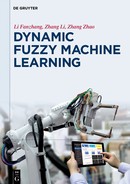0%
52Chapters
0-1Hours read
0kTotal Words
Table of Contents
- Cover
- Title Page
- Copyright
- Contents
- Preface
- 1 Dynamic fuzzy machine learning model
- 2 Dynamic fuzzy autonomic learning subspace algorithm
- 3 Dynamic fuzzy decision tree learning
- 4 Concept learning based on dynamic fuzzy sets
- 4.1 Relationship between dynamic fuzzy sets and concept learning
- 4.2 Representation model of dynamic fuzzy concepts
- 4.3 DF concept learning space model
- 4.4 Concept learning model based on DF lattice
- 4.5 Concept learning model based on DFDT
- 4.6 Application examples and analysis
- 4.7 Summary
- References
- 5 Semi-supervised multi-task learning based on dynamic fuzzy sets
- 6 Dynamic fuzzy hierarchical relationships
- 7 Multi-agent learning model based on dynamic fuzzy logic
- 8 Appendix
- Index
